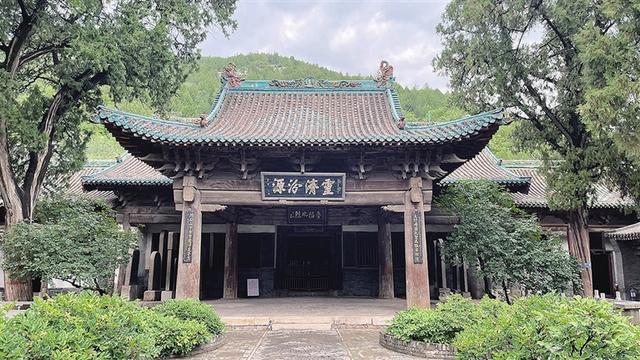Ancient scenery today can be found -walking into the Rising Mountain Museum
Author:Fairview Taiyuan City Time:2022.07.28

Doctor Dou Temple.

Lie Shihanquan.
There are three national key cultural relics protection units in the Sumiyama Museum -Dou Du Temple, Duofu Temple, and Jingyin Temple. What are you seeing here? This place not only has rich cultural relic resources such as ancient buildings, colorful plastic, murals, and inscriptions. It is particularly rare that it can also find the three scenes in the "Eight Scenery of Gujin Yang" in one stop: "Lie Shi Hanquan" and "Rising Red Leaf" "Tutang Monster Bai".
Follow Binhe East Road to the north, to the Shanglan Community on the Diaolian District of Doucal District. When you are about to arrive at the Dou Du Temple, you can hear the old branches cicadas. This place is quiet.
Dr. Dou Temple, also known as Lie Shi Temple and Yingji Heman Temple, is a temple built to commemorate Dou Yan during the Spring and Autumn Period. Although it has not been verified in the establishment of its establishment, it can be seen from the poem of the Tang Dynasty poet Li Duan "Tour visits once in Malaysia, and Dou Yan's legacy can be seen in the forest and mountains. In the temple, there is a inscription: "In the eight years of Song and Yuanfeng (1085), Dou Temple was flooded by Fen Shui, and the current temple was repaired in the twelfth year of the Yuan Dynasty (1275)." In the Ming and Qing Dynasties, the existing buildings were in the Yuan Dynasty.
Dr. Dou Temple is south to south, covering a total area of more than 17,000 square meters. The entire building is brick and wooden structure. There are more than 30 halls. With Dongxi ear houses, compartment rooms and bells and drums on the second floor.
Entering the ancestral courtyard, the shape is majestic, the eaves are raised, and the palace is like Dapeng's wings. It will firmly lock people's sight, open layout, and intriguing. What is even more amazing is its algae well. The logs are staggered, the arrangement is sparse, and the shape is rounded. It expresses the ancient people's understanding of the universe and is also the most representative building of Dou Du Temple.
One poem, one text, and one wood, all can be seen. During the Qianlong reign, a couplet written by Shen Rongchang, a scholar of Zhejiang: "Who is the traces of the Confucius of the Taixing Peak", "The Lie Shi Mountain Jinxian's legacy and Cangsheng". Dr. Dou's benevolence was also circulated on the land of Jinyang.
"Hongchao does not make a bang, and looks at Xishan Village. The clouds are ranging, and the pine Tao Tao heard it in detail ..." Drum Dou Dou drumped downstairs in the west side of the south hall of Dou Temple. The mountain is reading and writing in this hut. Because there was an old apricot in front of the house, he was named "Hongchao".
On the west side of Dr. Dou's Temple, the "Lie Shi Hanquan" in "Eight Scenery of Kuching Yang" is located. After repairing, people can meet the scenery of "Shi Rain wants to come and fog, the breeze moves the waves".
Looking at the Fenhe River with Doctor Dou, there are ancient temple Temple on the south slope of the Shengshan Mountains. It was built in the second year of Tang Zhenyuan and was destroyed by the fire at the end of the Song Dynasty. The Duofu Temple was built on the mountain. It is basically intact for the Sanjin Courtyard. The hill wall of the temple has 84 Buddhist stories painted by the Ming dynasty. The architecture, environment, scenery, and furnishings in the paintings are appropriate. The perspective is accurate, there is no sense of complication, and there is no disadvantage of empty. The color of the entire mural is mainly green and green, and the color of Zhu, Bai, Bai, 赭, and yellow is unique. The painting method is unique. The smooth lines make the whole mural extremely vivid and realistic, with high historical value and artistic value, and it is the quality of the mandarin in the Ming Dynasty temple. In the autumn, the red leaves are full of mountains.
Fu Shan wrote in his later years: "The moon is up to Donggang, and the Fenhe reciprocates Tutang." The "Tutang" in the poem is Jingyin Temple under the mountain under the mountains. It is composed of ancient buildings such as Shanmen, South Hall, Weituo Hall, Daxiong Temple, and Dogo Pavilion. The Great Buddha Pavilion is about ten meters high in the Great Buddha, which was founded in Jintai and Five years (1205 AD), commonly known as "Tusheng Great Buddha". The two ancient cypresses in the courtyard were relative. One of the bark texture direction is clockwise, and the other is in the direction of the clockwise direction. The two trees watch each other. Tusheng strange cypress "is located.
Looking at the ancient times, there is no ancient. Youbu Waishan Museum can view three "ancient scenes". We might as well start from here and gradually enter more museums to see ancient and modern blending, new and old and new shows.
Source: Taiyuan Evening News
- END -
Maoming Meteorological Observatory issued a thunderstorm and windy yellow warning [III class/heavier
At 10:57 on June 08, 2022, Maoming Meteorological Observatory released the thunderstorm yellow warning signal of Bohe Town and Electric Town of Binhai New District.
Ren Zhiyuan!The General Secretary made a scientific deployment of this major project

Source: Seeking.comAuthor: Xueshi Studio Studio